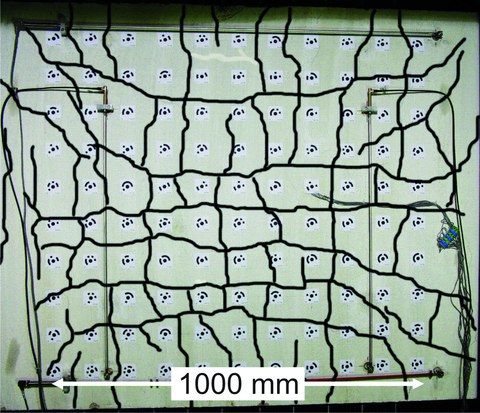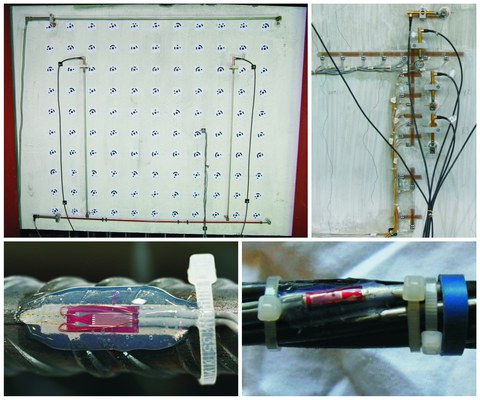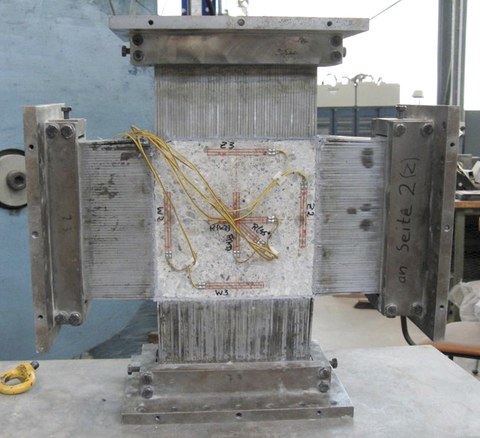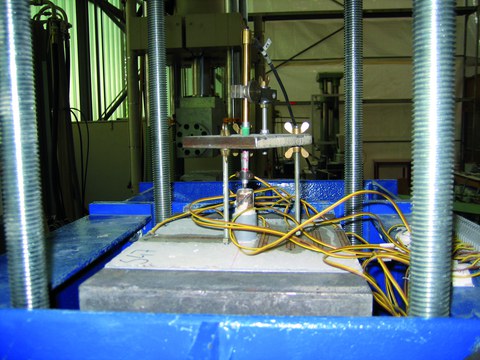Influence of transverse tension on cracking and bond between concrete and reinforcement in reinforced and prestressed concrete containments
Table of contents
Project data
|
Titel | Title |
Report in the yearbook 2011
Protective Cover from Reinforced and Prestressed Concrete

Crack pattern of a large-scale test after biaxial tensile loading
The safety of existing nuclear power plants depends on numerous factors. Therefore at international level, containments are used for pressurised water and boiling water reactors. However, the mere existence of such a protective cover does not guarantee a defined safety. Hence, the verification of integrity and tightness of the reinforced or prestressed concrete containment is of great importance. For this purpose, FE models are developed in order to provide realistic simulations of different scenarios. The prediction of realistic crack widths and leakage rates is important in case of increasing internal pressure and the resulting biaxial tensile loading, in order to guarantee the integrity and tightness of existing containments. For calibrating and verifying these analysis models, various tests have been conducted within this research project.
The bond behaviour of reinforcing steel under transverse tension has been determined on about 200 cubic-shaped pullout specimens with short bond length. With increasing transverse tension and decreasing concrete cover an early splitting failure occurs instead of pullout failure. With the equations deduced from the test results, local bond stress-slip relations can be expressed for any transverse tension level below the cracking load depending on the bar geometry, concrete strength and concrete cover. Also the bond failure mode as well as the point in time of failure can be determined.
Investigations on the biaxial tensile load bearing behaviour of plain concrete were conducted on 50 panels for two concrete strength classes and four tensile stress ratios. The test results showed the necessity to express a failure criterion depending on the concrete strength.
The interaction of all structural element components was tested on twelve large-scale reinforced concrete panels with post-tensioned tendons by means of biaxial tension tests. The biaxial tensile load influences the load bearing and deformation behaviour of the panels. Information about the stiffness, the initial cracking loads and the crack formation was determined.
1st report in the yearbook 2010
Reinforced and Prestressed Concrete under Transverse Tension

Instrumentation
In most cases, reinforced and prestressed concrete elements are part of three-dimensional structures, which are often exposed to multiaxial loads.
In case of prestressed concrete containments, an increase of internal pressure during hazardous incidents can lead to biaxial tensile loading of the structure. For realistic leak rate calculations, precise knowledge about the cracking process and crack development is necessary. The case of uniaxial loading is well investigated. However, it is expected that a tensile stress, acting transversely to the main loading direction, influences the bond behaviour between concrete, reinforcing steel and prestressing steel. Consequently, differences in the cracking process and the deformation behaviour for biaxial loaded structural elements occur compared to the uniaxial case.
Within the initial phase of the research project we already investigated the bond behaviour of reinforcing steel under transverse tension as well as the biaxial tensile strength of plain concrete plates by means of laboratory tests. The second phase of the project focused on investigating the load-deformation-behaviour of prestressed concrete elements under biaxial tensile loads. This was realised by full-size tests. Reinforced concrete panels with realistic structural element dimensions of 3.0 × 1.1 × 0.25 m with embedded post-tensioned tendons have been tested under biaxial tensile loading. The global and local deformation behaviour of the specimen has been recorded with extensive measuring techniques. Thus, strains of the different structural element levels - the concrete surface, the reinforcing steel and the prestressing strands – could be measured. The deformations of the concrete surface, the crack widths and spacing within a measuring area of 1.0 × 1.0 m have also been recorded using digital close-range photogrammetry.
The aim of the research project is to provide material parameters, which have been determined from the laboratory and full-size tests, for realistic FE-simulations of the deformation and the leakage behaviour of a prestressed concrete containment.
2nd report in the yearbook 2010
Concrete under Multiaxial Tensile Loading

Test specimen
Reinforced concrete elements are exposed to multiaxial tensile loads under operating and service states as well as exceptional loading situations. Uniaxial stress states in structural elements can be described precisely with material properties. However, multiaxial stress states demand more knowledge about the often differing material characteristics. Such varying material properties in turn influence the interaction of concrete and reinforcement (reinforcing and/or pre-stressing steel).
Based on these observations, in the past, investigations on the multiaxial strength of concrete had been conducted. In case of exposing the concrete to compression loads in two or three directions at the same time, the ultimate load generally increases compared with the uniaxial case. This strength increase can be exploited according to DIN 1045 e.g. for partially loaded areas or when applying the strut and tie model (compression joint). However, the conventional statements on the fracture behaviour of concrete under multiaxial tensile loads are not clear and vary from an increase in tensile strength, over remaining constant, to a decrease compared to the uniaxial tensile strength. Most of all, the tensile strength of concrete, when calculating the load bearing capacity, is not taken into consideration. But, concerning the bond lengths or verifications for the service state, the tensile strength cannot be neglected. When determining the crack width, the effective tensile strength of the concrete is part of the calculations at the regarded point in time. So, how does concrete behave under multiaxial tensile loads? So far, no standardised regulation exists for this subject.
The institute of concrete structures of the TU Dresden conducted tests on determining the biaxial tensile strength of concrete. The test program consisted of two concrete strengths classes – C20/25 and C40/50. Within each series, 24 discoidal specimens have been tested focussing on the stress ratios σ2 / σ1 = 0/1, 0.25/1, 0.5/1 and 1/1.
The result of the conducted tests was that an evaluation of the tensile strength concerning concrete under multiaxial tensile loads is only possible in dependency of the type of concrete. The biaxial tensile strength of the C20/25 equates to the uniaxial tensile strength. On the other hand, the biaxial tensile strength of concrete C40/50 decreases compared to the uniaxial tensile strength.
Report in the yearbook 2009
RC under transverse tension

Bond test under transverse tension
The three-dimensional structure of reinforced concrete containments is exposed to high internal compressive forces and temperature loads when hazardous incidents occur. As a result, tensile loads affect the behaviour of the reinforced concrete structure in both the hoop and meridian directions. If the load exceeds a critical limit, the biaxial stress state could lead to the onset of cracking at a lower level than expected from uniaxial laboratory tests. Precise knowledge of the initial cracking process and the progressive growth of existing cracks are needed to determine leakage rates and the evaluation of limit states when hazardous incidents occur. The goal of this project is to analyze changes in initial cracking caused by transverse tensile loads taking into account the specific bond conditions of post-tensioned tendons. The experimental results from this project are used to describe bond properties under transverse tensile loads that occur during pullout to predict and specify the deformation of the concrete containment during the state of initial cracking.
The project is divided into three parts, focusing on the following investigations:
- Bond behaviour between concrete and steel rebar reinforcement under transverse tension; experimental testing, in which the lateral tensile stress is less than the uniaxial concrete tensile strength, was used to examine the relationship between bond strength and tensile forces acting laterally to the reinforcement.
- The effects of biaxial tensile stress states on concrete tensile strength; differences in concrete tensile strength resulting from uniaxial and biaxial tensile loading need to be examined to insure the realistic modelling of stress and deformation of the bond area. A comparison between the biaxial and uniaxial tensile strengths was made.
- Bond behaviour of post-tensioned tendons under transverse tension. The mechanisms of bond transfer in this type of bond system require adjustment when additional elements, such as duct and grout, are applied. Future studies of full-scale specimens under transverse tensile loading will be conducted to gain further insight into these mechanisms.
